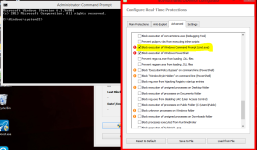- Jul 3, 2015
- 8,153
Has anyone else had a problem with MS Outlook, that the pst. file gets corrupted? I am not sure if this is caused by OSA or by Windows Defender Exploit Guard, and it only happens once in a while.
OSA doesn't intercept the file-system activities. If a process is blocked by it then the block will happen before the process in question can execute any of it's own code.I am not sure if this is caused by OSA or by Windows Defender Exploit Guard
WDEG does sound like a likely culprit, because it restricts writes to the Documents folder, where Outlook stores the pst files by default.OSA doesn't intercept the file-system activities. If a process is blocked by it then the block will happen before the process in question can execute any of it's own code.
if it's narrowed down to OSA and WDEG only then look at WDEG IMO. Have you set any custom rules?
Has anyone else had a problem with MS Outlook, that the pst. file gets corrupted? I am not sure if this is caused by OSA or by Windows Defender Exploit Guard, and it only happens once in a while.
You can add Outlook to excluded applications in Controlled Folder Access.WDEG does sound like a likely culprit, because it restricts writes to the Documents folder, where Outlook stores the pst files by default.
CORRECTION: It is Protected Folders that restricts writes to the Documents folder, not WDEG as I previously said.
There's not really a ball-mark estimation applicable to this question which is remotely close to being accurate or even half accurate.How effective is OSArmor against ransomware attacks without the need of a dedicated anti-ransomware software?
But the execution of the ransomware is still a process, no?There's not really a ball-mark estimation applicable to this question which is remotely close to being accurate or even half accurate.
One monitors process execution whereas the other monitors file-system activity and takes in various other characters into account. One may detect things the other won't and one may trigger more FPs for your specific environment than the other, and it may be completely different for someone else. Depends on your environment, habits/the ransomware sample, specific product/s in question and how they work, version of products being used, among other factors.
OSA and other traditional standalone anti-ransomware utilities can't really be compared because of the huge differences between the internals and design.
"Monitor and block suspicious processes behaviors to prevent infections by malware, ransomware, and other threats."
The question is how effective OSArmor is against ransomware attacks?
I think that @cruelsister's test is probably the best indicator, wouldn't you say? I don't remember the details of her test, but I don't think she would forget ransomware.How effective is OSArmor against ransomware attacks without the need of a dedicated anti-ransomware software?
Thanks
Thanks. Just remembed that video. Re-watch it.I think that @cruelsister's test is probably the best indicator, wouldn't you say? I don't remember the details of her test, but I don't think she would forget ransomware.
Yup, it is a companion software, not a complete security solution.Thanks. Just remembed that video. Re-watch it.
So even if all the settings are maxed out OSA still not effective against some ransomware
OSA has improved after that video, @cruelsister executed ransomware on desktop and now OSA can block unsigned processes on desktop.Thanks. Just remembed that video. Re-watch it.
So even if all the settings are maxed out OSA still not effective against some ransomware
That's good, for sure. But the downloads folder is still unprotected.OSA has improved after that video, @cruelsister executed ransomware on desktop and now OSA can block unsigned processes on desktop.
It should work fine.Does OS armor work with Windows Server 2016?


